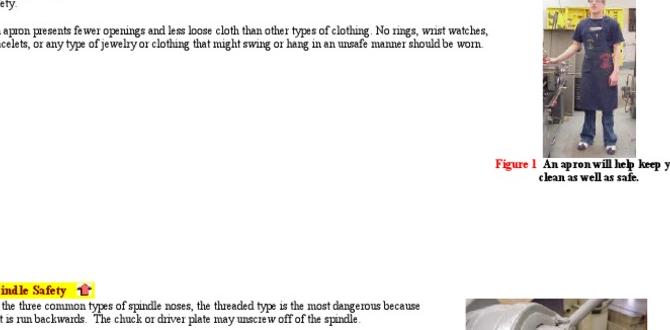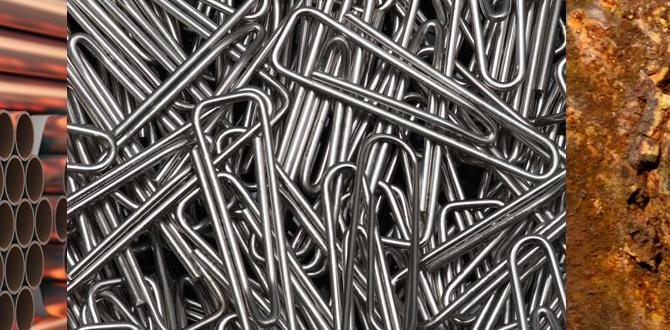Quick Summary: The TiAlN 40-degree ball nose end mill is a top choice for roughing G10 due to its heat resistance and durability, making G10 machining faster and cleaner. This guide shows you how to use it effectively for great results.
Working with G10 can be tricky. This tough composite material, often used in knife handles and electronics, can quickly dull standard tools. If you’ve ever struggled with G10 that chips, burns, or leaves a rough surface, you’re not alone. The good news? There’s a specific tool designed to make this job much smoother: the TiAlN ball nose end mill with a 40-degree helix angle. This guide will walk you through how to use it for essential G10 roughing.
We’ll cover everything from why this particular tool is so effective to the best practices for setting it up and running your cuts. You’ll learn how to achieve clean, efficient roughing passes that prepare your G10 material perfectly for finishing. Let’s get started and make G10 machining a breeze!
Mastering G10 Roughing with a TiAlN 40-Degree Ball Nose End Mill
When you’re machining G10, a material known for its strength and often frustrating tendency to wear down tools, having the right end mill is crucial. For roughing operations, especially when creating curved surfaces or pockets, a TiAlN (Titanium Aluminum Nitride) coated ball nose end mill with a 40-degree helix angle stands out as a fantastic option. This combination of coating, geometry, and helix angle is specifically suited to tackle the challenges of G10, leading to faster material removal, cleaner cuts, and longer tool life.
Why a TiAlN 40-Degree Ball Nose End Mill for G10?
Let’s break down what makes this tool so special for G10:
The TiAlN Coating: Your Heat Shield
G10 is essentially fiberglass reinforced epoxy. When you machine it, the friction generates significant heat. Standard coatings can’t handle this. TiAlN is a superb choice because:
- Superior Heat Resistance: TiAlN can withstand much higher temperatures than uncoated carbide or even other coatings like TiCN. This is vital for G10, which can soften and melt if overheated, leading to poor surface finish and rapid tool wear.
- Increased Hardness: The coating adds an extra layer of hardness and wear resistance, allowing the tool to cut through tough composite materials like G10 more effectively and for longer.
- Reduced Friction: It helps to lower the coefficient of friction between the cutting tool and the workpiece, further reducing heat buildup and preventing material from sticking to the flutes.
The Ball Nose Geometry: For Contours and Pockets
A ball nose end mill has a hemispherical tip. This makes it ideal for:
- Creating Radii and Fillets: Perfect for machining internal corners with a specific radius.
- Contouring and Profiling: Excellent for milling complex 3D shapes and curved surfaces.
- Roughing Deep Pockets: Allows for efficient material removal in recessed areas without bottoming out too quickly if designed correctly.
The 40-Degree Helix Angle: The Sweet Spot for Composites
The helix angle refers to the angle of the flutes around the tool’s axis. For G10 and similar composite materials, a 40-degree helix angle offers a great balance:
- Efficient Chip Evacuation: A steeper helix angle (like 40 degrees) can help to lift and clear chips away from the cutting zone more effectively. This is important because G10 can produce stringy, abrasive chips that can recut and damage the surface if not removed promptly.
- Smooth Cutting Action: It provides a good balance between shear and rake, allowing for a smoother cut and reducing the risk of chipping or delaminating the G10 material. Some materials benefit from lower helix angles, but 40 degrees is often optimal for composites like G10.
- Reduced Vibration: A moderate helix angle can help to dampen chatter and vibration, leading to a better surface finish and a more stable machining process.
Essential Setup and Machining Parameters
Getting the most out of your TiAlN 40-degree ball nose end mill involves more than just putting it in the collet. Proper setup and understanding your machining parameters are key.
Choosing the Right Spindle Speed (RPM)
Spindle speed, measured in revolutions per minute (RPM), dictates how fast the cutting tool spins. Too fast, and you risk overheating and burning. Too slow, and you won’t cut efficiently, leading to tool chatter and poor surface finish.
For G10 with a TiAlN coated end mill, a good starting point for RPM often falls within a moderate range. Specific recommendations can vary based on the exact diameter of your end mill and your CNC machine’s capabilities, but a general guideline for common sizes (e.g., 1/4″ or 6mm) might be between 8,000 and 15,000 RPM. Always consult your specific tool manufacturer’s recommendations if available.
Setting the Feed Rate (IPM or mm/min)
The feed rate determines how fast the tool advances into the material. This is just as crucial as RPM for preventing heat buildup and ensuring clean cuts.
A general rule for roughing G10 with a ball nose end mill is to use a moderate to aggressive feed rate. This means the tool is moving into the material at a consistent pace to take a decent chip. For a 1/4″ (6mm) end mill, you might start in the range of 20-40 inches per minute (IPM) or 500-1000 mm/min. It’s better to take slightly larger chips than very small ones that can rub and generate excessive heat.
Key takeaway: Aim for feed rates that allow the tool to cut aggressively enough to remove material efficiently without bogging down the spindle or creating excess heat.
Understanding Axial and Radial Depth of Cut
These terms refer to how deep the end mill cuts into the material with each pass:
- Axial Depth of Cut (Ap): How far down the flute the tool cuts.
- Radial Depth of Cut (Ae): How much material the tool engages sideways.
For roughing G10, especially with a ball nose end mill, you’ll typically want to:
- Keep Axial Depth of Cut Moderate: Don’t try to hog out too much material vertically in one go. A good starting point for a 1/4″ (6mm) end mill might be somewhere between 0.08 to 0.12 inches (2-3 mm).
- Use a Moderate Radial Depth of Cut: For full ball nose engagement when creating contours or pockets, the radial depth of cut is often set to a significant portion of the tool’s diameter. For roughing, you might engage 50% to 75% of the tool diameter. Some advanced strategies, like adaptive clearing, use very small radial depths of cut but higher feed rates for efficiency.
Coolant or Lubrication: Is it Needed?
Machining G10 can produce fine, abrasive dust. While some machinists prefer to machine G10 dry to avoid fouling, others find that a light mist of coolant or an air blast can significantly improve tool life and surface finish by keeping dust away from the cutting zone.
If you use coolant:
- Mist Coolant: A fine mist application is often preferred as it doesn’t oversaturate the material.
- Air Blast: A focused stream of compressed air can effectively blow chips and dust away.
Always consider your dust collection system and the environment where you are machining. G10 dust can be an irritant, so good dust extraction is paramount. See the Occupational Safety and Health Administration (OSHA) guidelines for proper handling of airborne contaminants.
Best Practices for Roughing G10
Beyond the machining parameters, several practices will ensure your G10 roughing operations are successful and safe.
Secure Workholding is Non-Negotiable
G10 is rigid but can chip or grab if not held down properly. Ensure your workpiece is firmly clamped to the milling machine table. For small parts, consider using double-sided tape specifically designed for CNC machining, vacuum fixturing, or a small vise. Avoid placing clamps in areas that will be machined.
Coolant or Dust Extraction – Choose Your Strategy
As mentioned, managing the dust is critical.
- Dry Machining with Dust Collection: Ensure your CNC machine has a robust dust collection shroud and a powerful vacuum system connected. This is often the cleanest method for hobbyists.
- Mist or Air Blast: If using coolant, apply it judiciously. A flood coolant system might be overkill and create a mess with G10.
Toolpath Strategies for Roughing
When programming your CNC, consider these roughing strategies:
- Pencil/Parallel Traces: For removing bulk material in pockets or contours.
- Adaptive Clearing: A highly efficient strategy that maintains a constant tool load by using a small stepover and high feed rate, following the contours of the desired shape. This minimizes tool wear and machining time.
- 3D Contour: For sculpting curved surfaces.
For roughing, aim to leave a small amount of material (e.g., 0.005″ – 0.010″ or 0.1-0.2 mm) for a finishing pass. This allows the finishing tool to take a light “wipe” cut for a superior surface finish.
Listen to Your Machine
Your ears are one of your best diagnostic tools. Pay attention to the sound of the cutting. If you hear:
- Screeching or High-Pitched Whining: Often indicates the tool is rubbing, feeding too slowly, or running too fast.
- Loud Chattering or Banging: Suggests the feed rate might be too high, the depth of cut too aggressive, or the workpiece/tool is not held securely.
- A Smooth Whirring Sound: This is generally what you want to hear – it signifies the tool is cutting effectively.
Tool Deflection and Runout
Even with a rigid setup, very long or thin end mills can deflect slightly. This is more of a concern for finishing passes, but during roughing especially, a slight deflection can lead to uneven material removal. Ensure your spindle has minimal runout (the wobble of the tool holder). For critical dimensions, you might need to perform a finishing pass to correct for any deflection that occurred during roughing.
Comparing G10 Roughing Techniques
Let’s look at how the TiAlN ball nose stacks up against other options for G10 roughing.
| Tool Type | Pros for G10 Roughing | Cons for G10 Roughing | Best Use Case |
|---|---|---|---|
| Uncoated Carbide Ball Nose End Mill | Relatively inexpensive. | Rapid tool wear due to high heat and abrasion. High risk of melting/gumming up. Poor surface finish. | Very light, short cuts where tool life is not a concern. Not recommended for significant G10 removal. |
| TiCN Coated Ball Nose End Mill | Better wear resistance and heat tolerance than uncoated. | Still prone to overheating with G10 compared to TiAlN. Can struggle with effective chip evacuation for G10. | Moderate G10 machining tasks. Better than uncoated, but not ideal for heavy roughing. |
| TiAlN Coated Ball Nose End Mill (40-degree helix) | Excellent heat resistance, high hardness, good wear life. 40-degree helix enhances chip evacuation and cutting smoothness. Ideal for smooth, efficient roughing of G10. | Higher initial cost than uncoated or TiCN. Requires precise parameter settings to maximize benefits. | Primary choice for G10 roughing, especially for complex shapes, pockets, and contours requiring efficient material removal and good surface prep. |
| ZrN (Zirconium Nitride) Coated Ball Nose End Mill | Good hardness and lubricity, can perform well on some plastics. | May not offer the extreme heat resistance of TiAlN for demanding G10 applications. | Lighter duty G10 machining, potentially for softer composites. |
| Diamond Coated Ball Nose End Mill | Extreme hardness, excellent for abrasive materials. | Very expensive. Can be prone to chipping if not handled with care or if improperly used. May be overkill for G10. | Extremely abrasive or hard composite materials, but TiAlN is often sufficient and more cost-effective for G10. |
Step-by-Step G10 Roughing with Your TiAlN Ball Nose End Mill
Ready to put it into practice? Follow these simplified steps:
-
Secure Your G10 Workpiece
Make sure your G10 is firmly clamped to your milling machine’s table. Vibration is the enemy here!
-
Install the End Mill
Insert your TiAlN 40-degree ball nose end mill into a clean collet and tighten it securely in your spindle. Ensure it’s seated properly.
-
Set Up Your CNC Program (or Manual Controls)
- Define Tool: In your CAM software or machine controller, set up a new tool. Input its diameter, number of flutes (usually 2 or 4 for this type), and importantly, its geometry (ball nose).
- Set Speeds & Feeds: Based on our earlier discussion and any manufacturer recommendations, set your Spindle Speed (RPM) and Feed Rate (IPM or mm/min).
- Define Depths: Set your Axial (Ap) and Radial (Ae) depths of cut for the roughing pass. Remember to leave a small amount for finishing (e.g., 0.005″ – 0.010″).
- Choose Toolpath: Select an appropriate roughing toolpath (e.g., adaptive clearing, pocketing).
-
Verify Z-Height Set
Carefully set your Z-axis zero point for the operation. Double-check this to avoid crashing the tool into the workpiece or table.
-
Prepare for Dust/Chip Management
Turn on your dust collection system, air blast, or mist coolant before starting the cut.
-
Perform a Dry Run (Optional but Recommended)
If possible for your machine, run the program without the tool engaging the material (or with the Z-axis raised significantly). This helps you spot any obvious programming errors. You can also do a “touch-off” by lowering the tool just above the material and running the program to visually confirm the path.
-
Start the Roughing Cut
Begin the machining operation. Monitor the sound of the cut and the chip formation. Be ready to hit the stop button if anything seems wrong.
-
Inspect the Roughing Pass
Once the roughing pass is complete, stop the machine and carefully inspect the material. Check for:
- Clean surfaces
- No signs of burning or melting
- Chips have been effectively removed
- Material remaining for finishing is consistent.
-
Set Up for Finishing
Now, you’ll typically switch to a finishing tool (often a smaller ball nose end mill or a sharp spot drill for edges) and use a much shallower depth of cut and often a slightly slower feed rate to achieve the final desired surface finish.
Troubleshooting Common Issues
Even with the right tool, things can go awry. Here’s how to address common problems when machining G10:
Burning or Melting
- Cause: Tool is rubbing, feed rate is too slow, spindle speed is too high, or not enough material is being removed per tooth.
- Solution: Increase feed rate, decrease spindle speed, or increase axial/radial depth of cut slightly to take a more aggressive engagement. Ensure your tool is sharp and not worn.
Chipping or Delamination
- Cause: Feed rate is too high, depth of cut is too aggressive, tool is dull, or workpiece is not securely fixtured.
- Solution: Reduce feed rate, reduce depth of cut, check tool sharpness, or improve workholding. A smaller radial depth of cut can sometimes help when profiling edges.
Excessive Dust or Poor Chip Evacuation
- Cause: Insufficient dust collection or coolant





